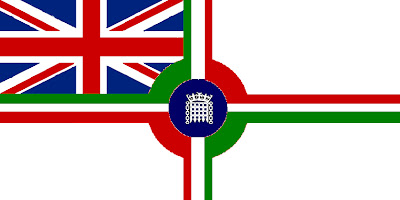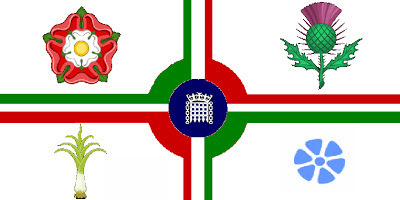First
the ceremony itself in short is when the Queen reads a speech
written by the government to parliament which outlines what it hopes to achieve in
the parliament year. it is full of both Royalist and slightly
Republican symbolism. For example this is one of very few occasions when the
Queen actually wears the crown of state symbolising the authority of the crown,
but also when Blackrod (the chief of security for parliament usually an ex
military officer) is sent to summon the House of Commons to the House of Lords
to hear the speech, the door is deliberately and ceremonially slammed shut and
he has to wait to be invited in, thus symbolising the sovereignty of the
people. If you like pomp and ceremony you can view it on Youtube.
Three of the four Royal Bodyguards take part in the ceremony. The Honourable Corps of Gentlemen at Arms, The Yeomen of the Guard and soldiers of the Household Division. (The Royal Company of Archers only take part in ceremonies in Scotland)
The Gentlemen at arms are the most senior of the Sovereign Bodyguards (Gentlemen at Arms, Yeomen of the Guard and Royal Company of Archers). They are mostly if not all retired military officers. They are more senior as they are the 'closed guard' and are classed as gentlemen rather than yeomen. Their uniform is based on that of a heavy dragoon in the Victorian period. Their standard is seen during the ceremony and can be seen below:
This is in the style of a carvery guidon, however it is a lot bigger. It has the Cross of St George in the hoist, beside which is the cypher of the reigning monarch (this picture is not of the current standard) beside which is the corps name, beside which is the corps badge which is similar to the bade of the palace of Westminster (the name of the building which Houses of Parliament) except with a royal crown. In the fly are two of the three battle honours. To get an idea of the full size see below:
The Yeomen of the Guard are the oldest military corps still in existence despite the fact they are junior to the gentlemen at arms. They are often mistaken for the Yeomen Wardens of the Tower of London known as Beefeaters. An easy mistake as the ceremonial uniforms of both are exactly the same except for a cross belt worn by the guards. Like the gentlemen at arms the are made up of former members of the armed forces however any rank can join not just officers. Their colour which is also seen at the ceremony is below:
Only the cypher changes, in the centre is the floral emblems of the Kingdoms of Scotland, England and Ireland. In each corner are the badges of houses (families) to sit on the throne. The House of Windsor at the bottom left, the House of Stuart at the top left. A crowned hawthorn bush and the letters HR, representing King Henry VII and the legend that the crown was discovered by the guard in a hawthorn bush following the Battle of Bosworth in the top right. A white horse on a green mound surmounted by the crown, representing the House of Hanover in the bottom right. Two of the company's seven battle honours are also displayed.
The Sovereigns bodyguards are ceremonial only and are made up of ex servicemen The Household Division are made up of serving soldiers most of which be deployed wherever the United Kingdom is engaged in military operations. There are two brigades in the division the foot guards are the famous guards with the red tunics and bearskin caps that guard Buckingham Palace. They are made up of five regiments (Grenadier Guards, Coldstream Guards, Scots Guards, Irish Guards and Welsh Guards) who rotate between ceremonial duties (or public duties as they are known in the military) training exercises, security and combat operations. At Parliament this year the Welsh Guards were the guard of hounour outside, their Queen's Colour was also on parade and can be seen below:

Unlike other army regiments the regimental colour is a Union Flag, not the Queen's Colour. The Queens Colour of the Welsh Guards has a Royal Crown and dragon, underneath which is the regiments motto: "Cymru am Byth" Welsh for 'Wales Forever' it is also emblazon with battle honours of which there are notably more than the cerimonaly guards as I already mentioned the Foot Guards are modern operation soldiers. Most are WW1 and WW2 battle hounours but the bottom one reads "Falkland Islands 1982" since this picture was taken I think ones for Afghanistan have also been awarded but I'm not too sure about that.
The next brigade is the Horse Guards which as the name suggests are mounted. There is only one regiment of Horse Guard the household Calvery but this is split into two seperate units the Life Guards and the Blues & Royals each of which have a mounted (horse) and armoured (tanks) corps in which troopers rotate. Their sovereign Guidon is carried when escorting the monarch to parliament:
Also of note are the Kings of Arms who are responsible for keeping records of heraldic arms and granting arms in England, Northern Ireland and Wales. They take part in the ceremonial uniform which are unchanged since the middle ages with the Royal Arms and their chains and staffs of offices.

Well that is the ceremony out of the way. The Union Flag being replaced by the Royal Standard when the monarch arrives is naturally part of the ceremony. Traditionally the Union Flag was only flown over parliament when Parliament was in session (when one or both of the two houses were meeting for debates, votes and lawmaking, not including committees or hearing). But the last Government led by Prime Minister Gordon Brown decided it should be flown everyday from Parliament buildings and 10 Downing Street. So it has lost its traditional communicative purpose. I recently seen an idea for a parliament in session flag to be used for this traditional purpose:

Presumably this will replace the UK flag on the Victoria Tower when used. Its a white ensign, which is in itself unusual. The charge on the fly is Coat of Arms of Simon De Montfort who called for the first elected Parliament in 1265 AD. Behind the arms, is a knights of the round table based upon the design at Winchester, that had 25 slots for 24 knights and one for the Lord or Sovereign.
I also had ago at a design:
I kept the white ensign design. However my design has a red, white and green cross design. This represents the two Houses of Parliament The House of Lords (whose colour is red) and the House of Commons (whose colour is green) In the centre is a blue disc with the badge of the Palace of Westminster (the parliament building)
The above flag is designed to replace the Union Flag on the Victoria Tower when used. However if a second flag pole was constructed for a parliament in session flag, or if it was used under the union flag, then their would be no need to replace the Union Flag so an ensign design with the national flag in the canton would not be necessary. In that case my alternative design is below:
It feature the Tudor Rose of England, Thistle of Scotland, Leek of Wales and Flax of Northern Ireland.Personally I think I like the ensign version but I would like know what you think.
All Comments welcome
Only the last two flags are of my design.






No comments:
Post a Comment